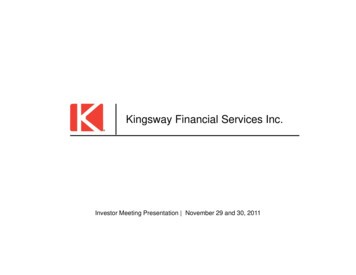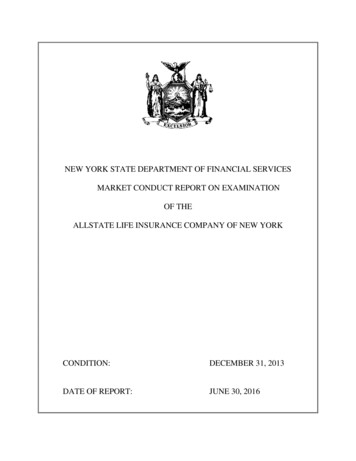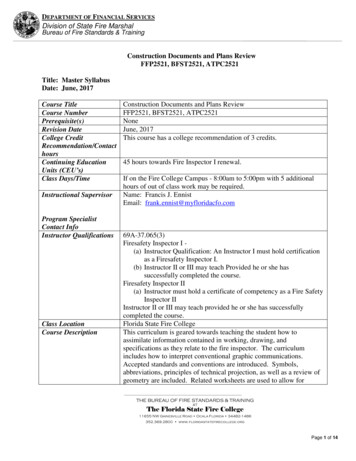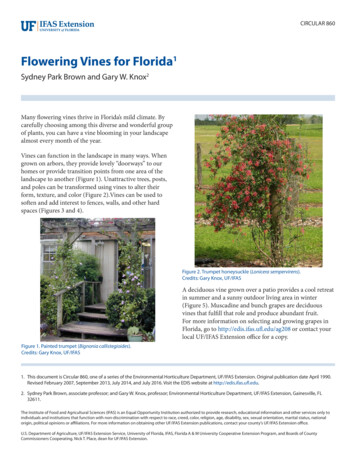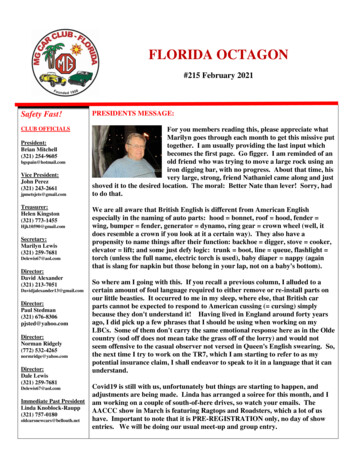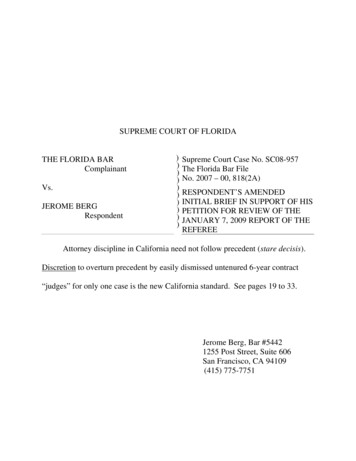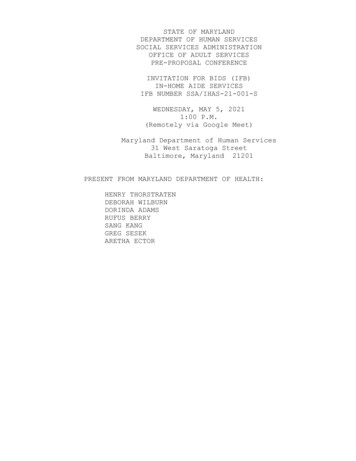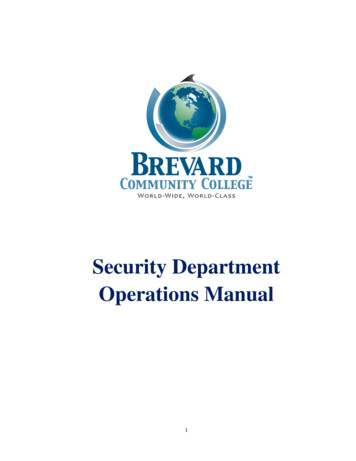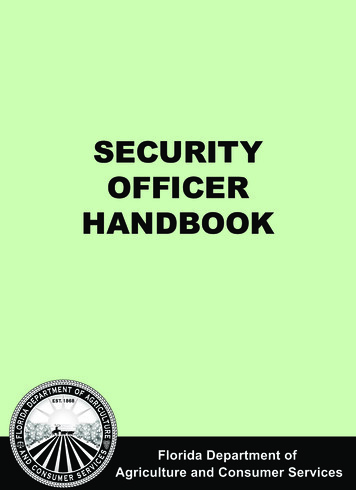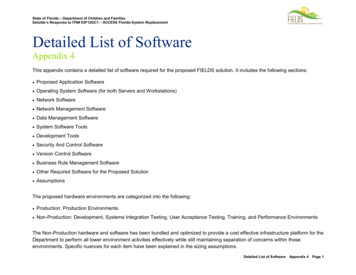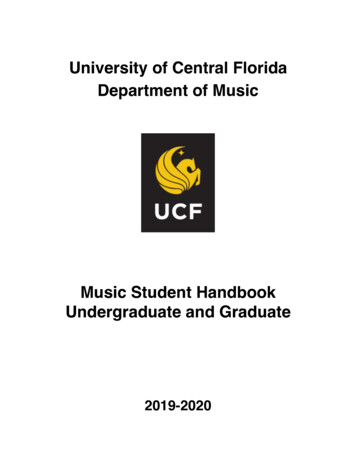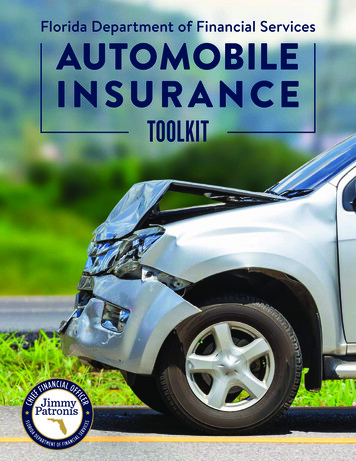
Transcription
Florida Department of Financial ServicesAUTOMOBILEINSURANCETOOLKIT
Automobile Insurance ToolkitInsurance coverage is an integral part of a solid financial foundation. Insurance can help usrecover financially after illness, accidents, natural disasters or even the death of a loved one.There are a wide variety of insurance products available and choosing the correct type andamount of coverage can be a challenge. This toolkit provides information to assist you withinsuring your automobile and tips for settling an automobile insurance claim.
TABLE OF CONTENTSClick a title or page number to navigate to a section.01Coverages & Minimum Requirements - 4Coverage Descriptions - 5Insurance Requirements for Special Cases - 802Underwriting Guidelines - 11Underwriting Factors That Cannot Affect Your Ability to Purchase Insurance - 11Underwriting Factors That Affect Your Insurance Policy Premium - 12Other Factors Affecting Your Premiums - 13Shopping for Auto Insurance - 1303Automobile Claims - 14Actions to Take Before and After an Auto Accident - 14Disputing Claim Settlements - 1604Shopping for Coverage Checklist - 17
01Coverages & MinimumRequirementsIn Florida, vehicle owners may be required topurchase two types of auto insurance.The first type of auto insurance is outlined in theFlorida Motor Vehicle No-Fault Law (s. 627.736, FloridaStatutes). It requires every person who registers avehicle in Florida to provide proof they have personalinjury protection (PIP) and property damage liability(PD), with minimum limits of 10,000 each. PIP coversinjuries you and certain others may incur in an autoaccident, regardless of fault. PD covers your liabilityif you damage property belonging to someone elsein an auto accident. Examples might include anotherperson’s vehicle, a telephone pole or a building.Individuals who are in the State of Florida with theirvehicle for more than 90 days in the last 365 daysmust carry these minimum limits of coverage. It isimportant to note that the 90 days do not need to beconsecutive in order for the law to apply. Questionsabout titling or registering your vehicle or furtherclarification on how Florida’s auto insurance laws applyto you should be directed to the Florida Departmentof Highway Safety and Motor Vehicles. You may visitthem online at www.flhsmv.gov or call (850) 617-2000.4 Automobile Insurance ToolkitThe second type of auto insurance is outlined in theFlorida Financial Responsibility Law. It requires driverswho have caused accidents involving bodily injury/deathor received certain citations, to purchase bodily injuryliability (BI) coverage with minimum limits of 10,000per person and 20,000 per accident, referred to assplit limits. You may purchase a policy that covers bothtypes of insurance required with a single limit of atleast 30,000. Drivers convicted of driving under theinfluence must purchase BI coverage in the amount of 100,000/ 300,000 and 50,000 in PD liability.The reason for the Florida Financial ResponsibilityLaw is to require owners or operators of motorvehicles to be financially responsible for damagesand/or injuries they may cause to others in an autoaccident. The failure to be financially responsiblemay result in the loss of driving privileges in Florida.Although there are other ways to prove financialresponsibility that are acceptable to the FloridaDepartment of Highway Safety and Motor Vehicles,our publication deals strictly with insurance.Table of Contents
Coverage DescriptionsBodily Injury Liability (BI)This coverage protects you for injuries or death tosomeone else that you are legally liable for resultingfrom a motor vehicle accident. As the owner of avehicle, anytime an accident occurs involving yourinsured vehicle (whether or not you are driving), thepossibility exists that you may be held financiallyresponsible for any damages. This coverage notonly covers the actual loss incurred, it can alsoprovide coverage for your defense if you are sued.When referring to BI limits of liability, the first numberrepresents the maximum amount of coverage you havefor each individual injured in a given accident and thesecond number is the maximum amount of coverageavailable to all injured persons in that accident.Let’s look at an example.You cause an accident and there are two peoplein the other vehicle. You chose to carry BIlimits of 10,000 per person and 20,000 peroccurrence. Person “A” sustained 25,000 dollarsin injuries and Person “B” sustained 15,000in injuries. How will your policy respond?EXAMPLEPerson “A”Person “B”Total Injuries: 25,000 15,000Their PIP Coverage: 10,000 10,000Your Responsibility: 15,000 5,000Payment from Insurer: 10,000 5,000Making a decision about the amount of coverage you should carry is a personal decision based on many factors.Discussing your coverage needs with a qualified insurance agent can help you better understand your options. It isimportant to remember that if an accident occurs, and the injuries sustained by another party are beyond the limitsof your insurance policy and the injured party has a permanent injury, scarring, disfigurement or is killed, they ortheir beneficiary may pursue recovery from you through the court system.Property Damage Liability (PD)PD liability pays for damage to another person’sproperty caused by you or someone else operatingyour insured vehicle. Most often this coverage willbe used to repair the other automobile(s) involved inan accident with your insured vehicle. It can also beused to pay for damage to street signs, mailboxes,buildings or other property owned by another party.Uninsured/Underinsured Motorist (UM)This coverage is optional but provides very importantbenefits to you and certain others who sustain injuriesfrom an auto accident caused by an uninsured orunderinsured motorist. The coverage allows you tocollect amounts from your own insurance carrier thatyou would have been able to collect from the at-faultparty if they had insurance or sufficient insurancelimits. It can provide additional medical expenses, lostwages, pain and suffering and other expenses thatmight arise when an injury occurs. Once coveragehas been triggered, benefits will be paid directlyto the injured person, normally in a lump sum.Table of ContentsYou may wonder why you need to purchase UMcoverage if you have PIP and health insurance since inmost cases, after your PIP coverage is exhausted, yourhealth insurance may pay some of your medical bills.Most health insurance policies include deductibles andcopayments which are out of pocket expenses for you.Health insurance normally does not provide coveragefor expenses you may incur if you or a covered familymember must stay in a convalescent center. In somecases when an injury is severe, permanent, or requiresa longer recovery time, it can be important for yourquality of life and financial health to have coveragethat will continue to pay for lost wages. Replacementservices may be required like lawn maintenanceor housekeeping. Due to your injuries, your homemay require modifications like a wheelchair rampor your vehicle may require special equipment.When purchasing UM, you must make two decisions.You must decide the limits you need and whetheror not you want stacked or non-stacked coverage.All insurance companies are required to providestacked UM with the same limits as your BodilyInjury coverage. Some insurance companies offer theoption to purchase lower limits and/or non-stackedAutomobile Insurance Toolkit 5
coverage. Stacked UM coverage means that the limitwill increase by the number of vehicles you own,regardless of whether or not the vehicles are insuredon the same policy. In other words, if you have stackedUM limits of 50/100 and own three vehicles, youractual coverage is multiplied times three or 150/300.If you elect non-stacked UM at 50/100, that is themaximum coverage available in an accident regardlessof how many vehicles you own. Another importantcoverage difference between the stacked and nonstacked form is how the policy will respond if youare injured by an uninsured/underinsured motoristin a vehicle you own, but do not have insured. Inthat case, only the stacked form would respond.Personal Injury Protection (PIP)You will often hear Florida referred to as a “No-FaultState.” This means that any time you are injured inan auto accident you will file your injury claim withyour own insurance company, regardless of who isat-fault. However, once an injured person piercesthe tort threshold, they may seek recovery for costsnot duplicated by PIP from the at-fault party.Section 627.737, Florida Statutes, states the thresholdhas been pierced when an injury from a car accidentresults in significant and permanent loss of importantbodily function, permanent injury, significant orpermanent scarring, disfigurement or death. Section626.9541, Florida Statutes, protects consumers froman increase in their premium for filing a PIP claimin a not-at-fault accident. Section 627.736, FloridaStatutes, details who is covered under your PIP but6 Automobile Insurance Toolkitthere are many variables which ultimately determinehow your policy will respond in a claim situation.The following describes situationswhen coverage applies:1.Injuries to named insured:a. If the accident occurs in Florida, whileoccupying any defined motor vehicle or ifstruck by a defined motor vehicle while notoccupying any self-propelled vehicle.b. If the accident occurs outside of Florida,while occupying the insured motorvehicle or a vehicle owned by a residentrelative, if it is insured for PIP.2. Injuries to resident relatives of named insured:a. Covered the same as the named insured.For accidents outside of Florida, thenamed insured’s benefits apply to therelative only when the relative is occupyingthe named insured’s motor vehicle.3. Persons other than named insured and relatives:a. If the person is not an owner of a motorvehicle or entitled to benefits from anotherowner’s insurance company and if the accidentoccurs in Florida, the owner’s benefits arepayable to such persons (1) while occupyingthe named insured’s motor vehicle or (2) if theperson is a Florida resident, if struck by theinsured’s motor vehicle while a pedestrian.Table of Contents
All Florida automobile policies are required to include the following standard PIP benefits: Regardless of who caused the accident, 80% of all necessary and reasonable medical expenses incurredas a result of a covered injury are included. It is very important to remember initial treatment must bereceived within 14 days of the accident to be covered. A limit of 2,500 applies to non-emergency medicaltreatment. If a medical doctor, an osteopath, a dentist, a physician’s assistant or an advanced registerednurse practitioner determines that the claimant suffered from an “emergency medical condition,”reimbursement for all services and care is up to 10,000, unless higher limits are purchased.An emergency medical condition is defined as: A medical condition manifesting itself by acutesymptoms of sufficient severity, which may include severe pain, such that the absence ofimmediate medical attention could reasonably be expected to result in any of the following: Serious jeopardy to patient health; Serious impairment to bodily functions; Serious dysfunction of any bodily organ or part. Coverage of 100% for necessary and reasonablereplacement services, like cleaning, cooking andyard maintenance, that the injured person isunable to perform.insurance company to determine how your policywill respond to a claim and what coverage optionsare more appropriate for your personal situation. In some cases, 60% of lost wages (due to work loss)are covered. Mileage related to healthcare travelis usually paid at the standard rate allowed by theIRS. A death benefit of 5000 is included.Medical PaymentsIn addition to the standard benefits above, thereare additional coverage options you may wishto consider. You may increase medical expensecoverage to 100% and lost wages coverage to80%, up to the policy limit. You may also increasethe maximum coverage available to 20,000.Not all insurance companies offer the increasedlimits discussed; however, all companies are requiredto offer deductibles and the option to exclude workloss. Section 627.739, Florida Statutes, states thatinsureds have the right to reject work loss benefitsin exchange for a premium reduction. A rejectioncan apply to the insured only, or to the insured andresident relatives. You may also choose a deductibleof 250, 500 or 1,000. The deductible canapply to the insured only, or to the insured andresident relatives. When a deductible is chosen, itapplies to all benefits except the death benefit.Medical Payments coverage is optional. It coversreasonable and necessary medical expenses andfuneral expenses incurred as a result of bodilyinjury from an auto accident, not covered by PIP,up to the limit chosen. Medical Payments coverageapplies to the named insured, resident relativesand others while a passenger in your insuredvehicle. Also, Medical Payments coverage followsyou and your resident relatives in any car, or asa pedestrian or bicyclist. Some people purchaseMedical Payments coverage to pay the 20 percentof medical expenses not covered under basic PIP,or to pay the PIP deductible if one was chosen.Coverage under PIP can be complicated. It isimportant to disclose to your agent or insurancecompany all the members of your household andany regular users of your vehicle when you initiallypurchase your policy and throughout the policyterm if members of the household and/or userschange. Any special circumstances or concernsyou have should be discussed with your agent orTable of ContentsAutomobile Insurance Toolkit 7
Comprehensive or Other than CollisionComprehensive, sometimes referred to as Otherthan Collision on your policy, provides coveragefor damage to your insured vehicle from fire, theft,windstorm, vandalism, flood, falling objects orfrom colliding with an animal. When you have thiscoverage, windshield glass claims are not subject toa deductible. This coverage is usually available even ifyou elect not to purchase Collision coverage. Commondeductible amounts are 250, 500 or 1,000. Youshould consult your agent or insurance company todetermine what deductibles are available to you.CollisionCollision coverage pays for the repair or actual cashvalue of your insured vehicle if it collides with anothervehicle, flips over or collides with another object(except animals). Common deductibles are 250, 500and 1,000 and insurance companies normally requirethe purchase of Comprehensive/Other than Collisioncoverage in order to purchase Collision coverage.In general, only equipment that is permanentlyattached to your vehicle is considered for coveragein a Collision claim. Tools and permanently attachedtoolboxes used in trade or a wheelchair lift or othercustom features added by you or a dealer should bediscussed with your agent or insurance company.Rental ReimbursementRental Reimbursement is another optionalcoverage. Normally, this coverage is only availableif you purchased Comprehensive and Collision.Rental Reimbursement provides coverage for thecost of renting a replacement vehicle in certainsituations. In the event of a covered loss, yourinsurance company will reimburse you for carrental expenses up to the limits specified in yourpolicy. Your insurance company is not responsible8 Automobile Insurance Toolkitfor rental reimbursement unless there is a coveredclaim that triggers the need for a rental car.While some insurance companies may pay for yourrental car in advance, eliminating the need for you toinitially pay out of pocket, they are not required by lawto do so. In fact, most contracts state that the insuredmust pay for the car rental in full and then submit thereceipts to the insurance company for reimbursement.Towing and LaborTowing and Labor is optional and provides coveragefor emergency road service (at the scene) and towingup to the limits shown on the policy. However, itis important to remember that frequent towingclaims can affect your coverage in a negative way.Insurance companies have the right to cancelyour policy for too many claims, even if they arelow dollar towing claims not associated with anaccident. Some policies settle towing claims on areimbursement basis and others have contracts withpreferred towing companies to provide the service.Insurance Requirementsfor Special CasesFinanced VehicleMost loan agreements require you to maintainComprehensive and Collision coverage for the termof the loan and to list the lender as a loss payee onthe policy. This protects the financial interests ofthe lender and also guarantees that the lender willreceive notification anytime the policy is changed oris pending termination. Some lenders offer insurancecoverage provided by a specific insurance company,but they cannot require you to purchase insurancefrom them or a particular insurance company or agent.They can also limit the amount of the deductible youcan choose. As with any contract, it is important thatTable of Contents
you understand the terms of your loan agreementand your responsibilities before signing it.If you fail to maintain the coverage required bythe lender, the lender will purchase insurance toprotect its interest in your vehicle. It is important tounderstand the lender is the named insured undera force-placed policy and you have no protectionor rights for recovery under the policy. This meansif you have an at-fault accident, you can be heldlegally liable for damages. In addition, force-placedpolicies typically do not meet the requirements ofthe Financial Responsibility Law administered by theFlorida Department of Highway Safety and MotorVehicles. Therefore, you could risk the suspension ofyour tag and driver’s license. In addition, the cost of theforce-placed policy will be passed on to you and mayincrease the number and/or amount of your monthlypayments. Generally, you pay less when you buy yourown coverage. You should keep all insurance recordsuntil you pay off your vehicle and receive the title.Leased VehicleYou should also carefully review the lease agreementto identify any additional requirements that arepart of the contract between you and the lessor.MotorcyclesA separate policy is required for motorcycleswhich cannot be added to an existing auto policy.Most of the coverage offered on an auto policycan also be purchased on your motorcycle policy;however, PIP is not available on motorcycles. PIP isonly required for self-propelled vehicles with fouror more wheels that are registered and licensedin the state. Also, PIP coverage on your autowill not cover you while riding a motorcycle.Questions related to vehicle registration, tags ordriver’s license requirements should be addressedto the Florida Department of Highway Safetyand Motor Vehicles. You may visit them onlineat www.flhsmv.gov or call (850) 617-2000.College Students or Part-Time ResidentsAny person who has a motor vehicle in Florida formore than 90 days during the previous 365-dayperiod must have PIP and PD insurance. The 90 daysdo not need to be consecutive for this to apply. If youare a Florida resident attending college in anotherstate and your vehicle is registered in Florida, youmust have PIP and PD coverage on the vehicle.Military PersonnelIf you are in the military, have a Florida-titledvehicle garaged out of state, and insure the vehiclewith a policy issued in your state of residency,send a copy of your orders and a copy of theinsurance policy to the Florida Department ofHighway Safety and Motor Vehicles. This willprevent the suspension of your tag and license.If you are called to active duty and will serve outsideof the United States in an emergency situation,you are exempt from carrying PIP and PD as longas you remain outside of the United States andallow no one else to use your automobile. Youmust request this exemption from y
4 Automobile Insurance Toolkit Table of Contents. In Florida, vehicle owners may be required to purchase two types of auto insurance. The first type of auto insurance is outlined in the Florida Motor Vehicle No-Fault Law (s. 627.736, Florida . Statutes). It requires every person who registers a vehicle in Florida to provide proof they have .File Size: 727KB
